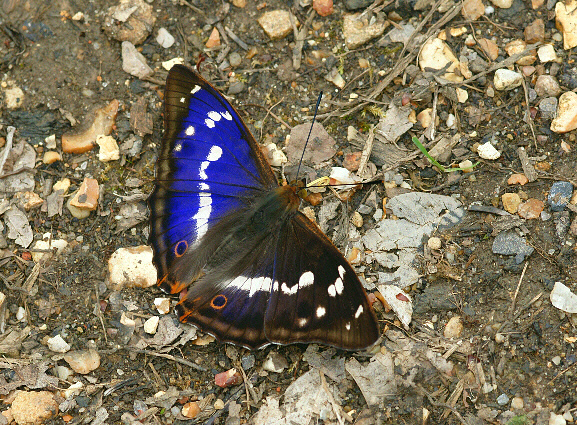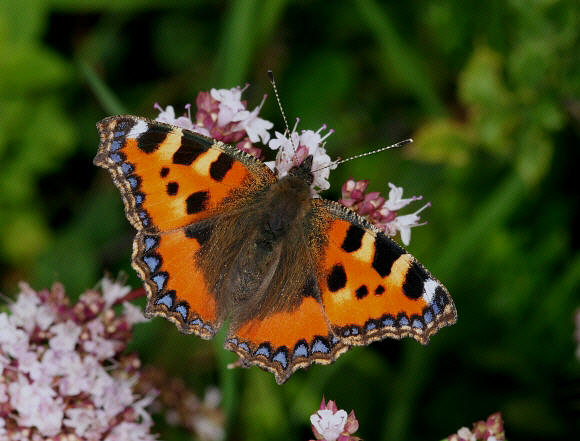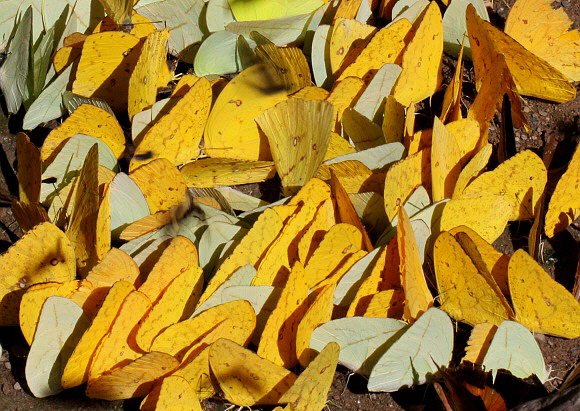Butterflies occur in an incredible variety of shapes, colours and patterns. Each design serves a dual role. Firstly it acts as an identity badge, advertising the butterfly to potential mates. Secondly and equally importantly it functions to protect the butterfly from predators, e.g. by using camouflage, disguise, aposematic or diematic coloration, mimicry or transparency.
It is possible of course to read too much into the “colour for survival” theme. There doesn’t have to be a survival-related reason for every nuance of pattern or colour. After all what possible difference could it make if a caterpillar has a brown head instead of a black one ? Having said this however it is quite obvious that a butterfly that is camouflaged as a dead leaf has a considerably higher chance of avoiding predation than one that is not.
Butterflies have short lives – typically less than 2 weeks as an adult, so they need to quickly locate mates. Many species lose their attraction to the opposite sex within just a day or two of emergence because their pheromones become exhausted. Rapid mate recognition is therefore vital.
The first stage in the recognition process consists of intercepting any flying object of roughly the same size and colour as their own species – in the neotropics for example it is easy to attract blue Morpho butterflies by waving a piece of blue foil in the air.
 Purple Emperor Apatura iris, male – Adrian Hoskins
Purple Emperor Apatura iris, male – Adrian Hoskins
In many genera e.g. Apatura, Morpho and Doxocopa the wings of males have a highly reflective blue sheen. During flight their wings glint brilliantly in the sunshine and probably play a major role in mate location and recognition.
Once initial contact has been made, a combination of olfactory and visual factors hold the interest of both sexes as a precursor to the courtship ritual. Visual stimuli include holding the wings or body at particular angles, flicking the wings, or simply displaying the patterns by opening the wings.
During the courtship process a series of exchanges takes place during which various stimuli trigger either negative or positive responses. A negative response might indicate that the potential mate was not of the same species, or was unwilling to mate – females of many Pierids for example signal an unwillingness to mate by raising their abdomen and outspreading their wings.
A positive response invariably triggers another visual, olfactory and tactile stimulus, which leads to another response. By going through these stimulus / response sequences the butterflies are able to determine firstly that they are of the same species, then that they of opposite sexes, and finally that both are ready and willing to to mate. In some species this process is very brief, but in others such as the Small Tortoiseshell Aglais urticae, it is protracted and may take several hours during which the male doggedly follows the female from place to place, persuading her to copulate.
 Small Tortoiseshell Aglais urticae – Adrian Hoskins
Small Tortoiseshell Aglais urticae – Adrian Hoskins
Male butterflies will usually intercept both sexes of their own species. The purpose of male-male sorties is to challenge and oust an intruding male from the territory of another, thereby increasing the territory owner’s chances of success with any female that passes by.
Males also “know” that they can often find food by following other males : In tropical regions males of many species visit sandbanks and damp paths to indulge in “mud-puddling”. Their purpose is to imbibe mineralised water, from which they obtain vital salts. These are passed to females during copulation and are believed to be essential for the production of fertile eggs.
Typically just one or two males will chance upon a suitable feeding spot, but other butterflies flying past seem able to recognise their brethren on the ground, and swoop down to join them. The bright patch of colourful butterflies quickly becomes a magnet to every passing male of the same species.
Often several different species may be present at these feeding places. In these circumstances one might expect each species to be spread randomly within a large group, but in fact each butterfly polarises very strongly to it’s own brethren, so that each species congregates as a discrete group.
In calm weather the butterflies in each group are positioned randomly, but on riverbanks there is usually a constant gentle breeze, so all the butterflies in each group tend to face into the breeze as this way they are less likely to be blown about and lose their feeding spot to a competitor.
 Phoebis argante and Rhabdodryas trite aggregating at Rio Shima, Satipo, Peru – Adrian Hoskins
Phoebis argante and Rhabdodryas trite aggregating at Rio Shima, Satipo, Peru – Adrian Hoskins
